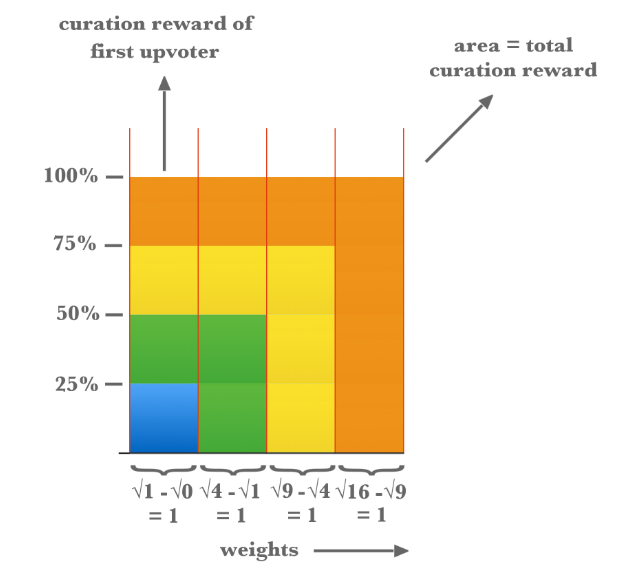Hey @blocktrades and @beshadow I was reading through these comments and just randomly thought I would drop in and give a few thoughts.
I also had a ton of questions as far as curation rewards are concerned, especially post HF20.. Right after the fork, I spent a lot of time testing and scratching my head on exactly how curation rewards work on the blockchain and how you can predictably measure your earnings and potential earnings given a set of different variables and circumstances.
I happened upon a discovery that made me so happy... It's a post made by @miniature-tiger. Although it was made 1 year ago, most of it still applies (except for the window being 15 minutes now instead of 30). I recommend you go check it out, it gets pretty technical, but I have yet to see anyone explain and distill it in such an easy to understand way as miniature-tiger does! (https://steemit.com/curation/@miniature-tiger/an-illustrated-guide-to-curation-from-the-simple-to-the-complex-with-real-examples-from-past-posts-part-2)
Here's an excerpt that I think may help answer your original question:

The left hand column (anchored by the blue square) represents the amount of the curation rewards for the curation hound. Each area the size of the blue square is $0.25 worth of curation rewards, generated by $1.00 of upvote. For each successive colour it makes no difference to this example whether one upvoter adds all of the additional post payout or whether it is split between a large number of upvoters.
The milestone increases in curation that we are aiming to derive are as follows:
- Blue: The curation hound adds the first $1.00 to the post payout and at this point would receive all of the curation rewards of $0.25. Their curation weight is √1 - 0 = 1 (the curation weights are based on rshares in practice but here we have scaled them down to the level of the upvotes for simplicity).
- Green: The post payout needs to increase to 4x the original upvote in order for the reward paid to the curation hound to double from 25% of upvote to 50%. At this point the post payout is $4.00, the total curation reward is $1.00, and the weight share for the first upvoter is 1/2 giving a curation reward of $0.50.
- Yellow: The post payout needs to increase to 9x the original upvote in order for the reward paid to the curation hound to treble from 25% of upvote to 75%. At this point the post payout is $9.00, the total curation reward is $2.25, and the weight share for the first upvoter is 1/3 giving a curation reward of $0.75.
- Orange: The post payout needs to increase to 16x the original upvote in order for the reward paid to the curation hound to quadruple from 25% of upvote to 100%. At this point the post payout is $16.00, the total curation reward is $4.00, and the weight share for the first upvoter is 1/4 giving a curation reward of $1.00.
These figures are intuitive once we consider that the curation reward curve is a square root curve such that each linear increase in curation rewards requires the square of that increase in post payout.
I hope that helps! This obviously gets a lot more complicated as other voters/curation window get added to the mix, but I've run some field tests and have found the calculations to be both useful and on target.
Thanks, that is helpful, but on it's own it doesn't fully answer his question, since I'm not sure what the rewards wind up being for the "10th voter out of 20 case".
My bad @blocktrades, I should've addressed his question more directly lol. This made me do a much deeper dive than I intended to, but here goes. I may have gone slightly overboard with this, but it started as some back of the envelope calculations and now I've come up with the following chart. It should shed light on his specific question and case study of being the 10th voter out of 20.
Please note that @beshadow did not mention the value of the votes that came in the 9 votes preceding his 10th, thus I assumed it as being $5 for this example. You can input whatever number you like and the calculations will play out accordingly - the greater the value of the votes preceding yours, the less your curation reward will be.
Another note: as I mentioned before, it doesn't matter if 100 people vote before you or if 3 people vote before you or if 1 person votes before you. The only thing that matters is the value of the vote(s) preceding yours
you may have to zoom in on your browser to see the image. Otherwise right click and copy image address and open in your browser:
To verify my the math on these charts, example #1 uses the equations of #2 and #3 and applies them to the example provided by @miniature.tiger in his post that I linked in my first comment.
As you can see, example #1 hits the exact same result as miniature.tiger's chart, so we've verified that the equations are actually correct ;)
Conclusion
It's a very steep downward curve when it comes to not being the first voter.
If you vote on a post that is already at $5 with a $0.30 vote, and the post still goes up 4x in value to $20 after your vote, you won't make much Curation Reward at all.
However, if you're the first one who votes on a post with $0.30 and then the post goes up to $2 afterwards, you'll earn a Curation Reward that is equal to 65% the value of your original vote - a 40% increase from your original 25% curation reward.